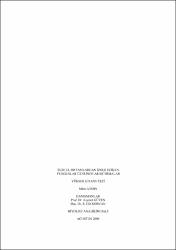| dc.contributor.advisor | Güven,Kıymet | |
| dc.contributor.advisor | Korcan, S. Elif | |
| dc.contributor.author | Aydın, Mine | |
| dc.date.accessioned | 2019-05-31T06:09:38Z | |
| dc.date.available | 2019-05-31T06:09:38Z | |
| dc.date.issued | 2009 | |
| dc.identifier.uri | http://hdl.handle.net/11630/6384 | |
| dc.description | In the present study, seven halotolerant and one halophilic fungi isolates gained from İzmir Çamaltı Saline and Iğdır/Tuzluca Rock Salt Bed. Isolates were identified by using conventional and molecular methods. DNA sequence analysis were used molecular identification methods. In DNA sequence analysis; ITS region, P-tubulin and Calmodulin gene were aligned. The fatty acids in fungi were determined by using fatty acid methyl ester (FAME) method. The heavy metal tolerance for Pb, Ni, Cr, Zn, Cd, Cu and Co were also determinated. As a result of heavy metal tolerance; halotolerant Penicillium chrysogenum isolate for Pb and halophilic Sagenomella sp. isolate Cd and Zn was found active for using heavy metal biosorption. Biosorption experiments were carried out with concentrations of the heavy metal; 145, 644, 1388 mg/lt Pb (pH 5), 95, 226, 310, 486 mg/lt Cd (pH 5) and 61.9, 132.6 mg/lt Zn (pH 6). Elemental analyses were carried out by using coupled plasma optical emission spectroscopy (ICP-OES). The maximum biosorption were determinated at Penicillium chrysogenum %95.24 (120. hour) of 145 mg/lt Pb, Sagenomella sp. %78.63 (96. hour) of 95 mg/lt Cd and %54.1 (96. hour) of 61.9 mg/lt Zn. The biosorption data fungi were fitted Freundlich isotherm (R2:0.939, 0.969, 0.970). The possible cell-metal ions interactions was evaluated by fourier transform infrared spectrometer (FT-IR). FT-IR analysis showed that amide (1595-1700 cm-1) was the active compound in the cells to biosorb lead, cadmium, zinc | en_US |
| dc.description.abstract | Çalışmamızda; İzmir Çamaltı Tuzlası ve Iğdır/Tuzluca Kaya Tuzu Yatağı’ ndan, 7 halotolerant ve 1 halofilik fungus izole edilmiştir. İzolatların geleneksel ve moleküler yöntemle identifikasyonları yapılmıştır. Moleküler yöntemle identifikasyonda DNA dizi analizi kullanılmıştır. DNA dizi analizinde; ITS bölgesi, P-tubulin ve Kalmodulin genleri dizilenmiştir. Ayrıca yağ asidi metil esterleri (FAME) analizi ile funguslardaki yağ asitleri belirlenmiştir. Pb, Ni, Cr, Zn, Cd, Cu ve Co metalleri için ağır metal toleransı belirlenmiştir. Ağır metal toleransı sonucu, metal biyosorpsiyonunda Pb için halotolerant Penicillium chrysogenum, Cd ve Zn için Sagenomella sp. izolatları ile çalışılmıştır. Biyosorpsiyon deneylerinde, 145, 644, 1388 mg/lt Pb (pH 5), 95, 226, 310, 486 mg/lt Cd (pH 5) and 61.9, 132.6 mg/lt Zn (pH 6) kullanılmıştır. Element analizleri için indüktif eşleşmiş plazma optik emisyon spektroskopisi (ICP-OES) kullanımıştır. Maksimum biyosorpsiyon; Penicillium chrysogenum 145 mg/lt Pb için %95.24 (120. saat), Sagenomella sp. 95 mg/lt Cd için %78.63 (96. saat) ve 61,9 mg/lt Zn için %54.1 (96. saat) olarak belirlenmiştir. Biyosorpsiyon datalarının, Freundlich izotermine (R2:0,939, 0,969, 0,970) uygun olduğu gözlemlenmiştir. Hücre ile metal iyonlarının etkileşimi fourier transform infrared spektrometre (FT-IR) ile değerlendirilmiştir. FT-IR analizi; kurşun, kadmiyum ve çinko biyosorpsiyonunda hücredeki aktif fonksiyonel grubun amid (1595-1700 cm"1) olduğunu göstermiştir. | en_US |
| dc.language.iso | tur | en_US |
| dc.rights | info:eu-repo/semantics/openAccess | en_US |
| dc.subject | Halofilik ve halotolerant funguslar, identifikasyon, FAME, ağır metal biyosorpsiyonu, ICP-OES, FT-IR. | en_US |
| dc.title | Tuzcul Ortamlardan İzole Edilen Funguslar Üzerinde Araştırmalar | en_US |
| dc.title.alternative | Investigation of Fungi Isolated from Saltern Areas | en_US |
| dc.type | masterThesis | en_US |
| dc.identifier.startpage | 1 | en_US |
| dc.identifier.endpage | 133 | en_US |
| dc.relation.publicationcategory | Tez | en_US |



















